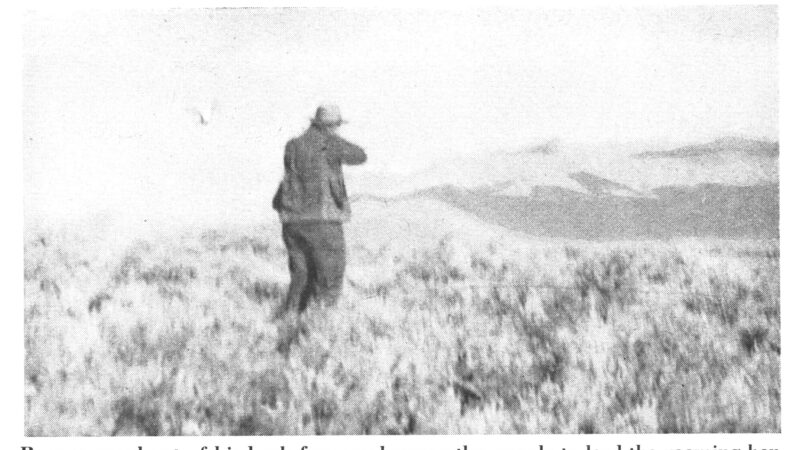Are Wolves Following Moose into Nevada State Reports First Wolf Pack Sighting in 100 Years
A wolf pack was seen in Nevada this month for the first time in more than a century, according to the Nevada Department of Wildlife. Officials say a helicopter crew contracted by the agency spotted the three “suspected” wolves on March 17 during a moose survey near Merritt Mountain, which lies north of Elko in the same region where an estimated 100 moose now live and a new moose season is scheduled for this fall. Although state officials are still working with the U.S. Fish and Wildlife Service to confirm the sighting, all signs point to the wolves drifting into the state from Idaho.
“During search efforts to confirm the sighting last week, biologists discovered tracks in the area,” NDOW explained Wednesday. “The freshest tracks appeared to be a set that led in the direction of the Idaho border, where they were lost in broken snow conditions.”
The agency added that biologists measured those tracks and found them to be consistent with gray wolves. They also installed trail cameras and collected scat and hair samples for DNA testing. Those test results are expected within the next few days.
Read Next: Nevada’s First-Ever Moose Season Excites Hunters as Big-Game Applications Open
“We are doing all we can to gather information regarding this sighting and will keep the public updated as we learn more information,” NDOW director Alan Jenne said. “Nevada is not a historic habitat for wolves, and we’ve had very few confirmed sightings in the state. Wolves are not known to reside in the state of Nevada, but we know that they may occasionally cross state lines for brief periods.”
The last time this occurred was in 2017, when a lone gray wolf was spotted west of the Black Rock Desert not far from the California border. Before that, there hadn’t been a confirmed sighting in the state since 1922, according to the Nevada Current.
Western wolf populations have rebounded in a big way since the species was reintroduced in the 90s, however, and it wouldn’t be at all surprising if the wolves were moving into the area from other states. Nevada is literally surrounded by wolves, with all five neighboring states harboring at least some of the animals.
Utah has the smallest number of wolves among the five states, with an estimated 20 gray wolves currently living in the northeast corner near the borders of Idaho and Wyoming. Next is California, which is home to an estimated 45 gray wolves and seven named packs. Arizona is home to a different species, the Mexican wolf, but their numbers have been growing for eight rows in a row now, with the most recent survey showing 144 individuals. (Because of where the wolves were seen in Nevada’s northeast corner and the federal regulations establishing separate recovery zones for the two species, it’s almost certain that the wolves spotted in Nevada earlier this month were gray wolves and not Mexican wolves.)
The largest source populations for Nevada’s wolves lie to the north in Oregon and Idaho. These states currently hold around 178 and 1,337 gray wolves, respectively.
Map by Idaho Rangeland Resource Commission
Management of the species is especially controversial in the Gem State, where the overall population exceeds the original recovery goal set by USFWS by around 37 percent. This has led the Idaho Department of Fish and Game to loosen regulations around wolf hunting and trapping, with no bag limits and year-round harvest allowed in parts of the state.
Most of Idaho’s wolves live in the central mountains north of I-84, with the closest known wolf pack to Nevada inhabiting the area around Mountain Home, according to the most recent map from 2015. But wolf packs are known to move around, and harvest data from IDFG shows that at least some gray wolves have been trapped and killed south of I-84 since then.
Read Next: How Many Wolves Should There Be in Colorado?
Wildlife managers have also seen this diaspora occurring in other parts of the West, most notably in Colorado. In 2019, four years before the state reintroduced gray wolves through a controversial ballot measure, Colorado Parks and Wildlife announced that a collared female wolf had crossed the Wyoming border into Jackson County. By 2021, that wolf had found a mate and given birth to a litter in the county, establishing the state’s first known wolf pack since the species was declared “off the landscape” in 1940.
Although Nevada currently has no plans to reintroduce gray wolves, it seems they might not need to. And now that the Silver State is home to a growing moose population, these wolves have roughly 100 reasons to stick around.
The post Are Wolves Following Moose into Nevada State Reports First Wolf Pack Sighting in 100 Years appeared first on Outdoor Life.
Source: https://www.outdoorlife.com/conservation/nevada-wolf-pack-sighting/



